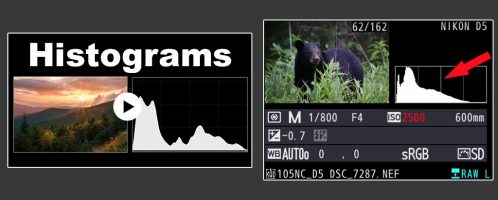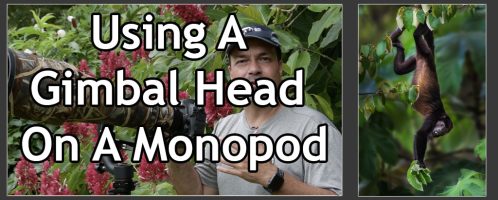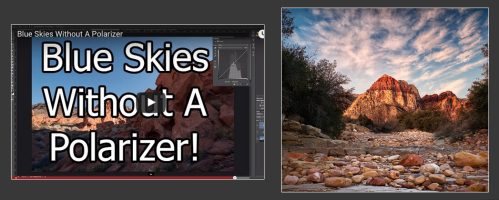One of the most common problems I observe while in the field – and during my workshops – is when someone can’t find the subject in their viewfinder while using a telephoto lens. Nothing’s quite as cringeworthy as watching a photographer flail around with their glass in a desperate attempt to capture an image before the opportunity disappears (oh, and it usually does).
Of course, it doesn’t have to be like this. I use a very simple technique that allows me to consistently place my subject right in the viewfinder the first time, every time with my long glass. No gimmicks, no gadgets, just put the viewfinder to your eye and – BAM – there it is.
Wanna know how? Check out the video 🙂
.
PS – If you enjoyed this post, I think you’ll REALLY like my e-books and video workshops! Thousands of pages and hours of videos filled with tips, tricks, and techniques – all my best content! Check ’em out – click here (hey, it’s free to look).




Thanks for this. I’ve been practicing this technique with my binoculars since I started birding 40 years ago but general stupidity has made me fail to see that it would work just as well with a camera and long lens.
Great video, as usual. But I’m LEFT eye dominant ….any suggestions? Similar technique, I assume…
Yup, exactly the same the technique.
This is one of the best bits of advice I got…..
Thanks. Figures …
Hi Steve,
after listening to your 500PF review I ordered one – got this 2 Weeks ago. Now I saw this – just in time for use with my new lens and a D500 – this is really small field of view.
Works “out of the box” with stationary subjects – but I think I have to practise body rotation for moving subjects.
Thanks for this advice.
One more detail. You need a consistent hand position grip on the camera and lens or the aim will change. I noticed this when trying to settle on the best way to hold my NEW 500PF. It’s the first 500 I’ve been comfortable hand holding.
Hi Steve, thx a lot for the tip and all the rest of them on your site and in the books. I have a trick to share as well. It is derived from star gazing technique. Telescopes have very narrow field of view – hence fixing a gaze at the star is not precise enough. First there has to be a distinctive feature at the far end of lens at the right spot to be used as aim. I am using knob on lens hood as it can be rotated to the place where it is at the same level… Read more »
Great video! I photograph football and can use this technique for taking photos of wide receivers.
Once again, an excellent video
This has been a “monkey on my back for some time” I miss so many shots, I’m sure you will have helped me get some more keepers in the future
Thanks great demo and so simple, and this is exactly what the birds and animals do when they stalk prey – head focused everything else moves
If only I had this advise years ago.
As usual your tips are great. Keep em coming Steve.
Steve, that is the same way my father taught me to hunt with a shotgun. Good video
Steve, What are you expecting in the D6 for 2020 Summer Olympics? Think this will be the last flagship DSLR?
No clue LOL. I’m confident it’s coming, and my guess would be it’ll up the the frame rate, have a a bottomless buffer, possibly better AF, etc – pretty much just improve everything that’s there. Nikon is pretty conservative with the pro bodies. I’d like to see around 30MP, but rumor has it we’re looking at 24 or so.
My biggest problem is small birds perched in trees. With small branches in front and large trees behind, the autofocus switches back and forth and by the time I finally have the bird in focus, it moves on.
Yes. Don’t look in the VF, look through it!
DANG! I wish I would have said that in the video – perfect summary!!
Good practical advice. Thank`s Steve
All great advice Steve—and second nature to an old shotgun wing shooter.
My Dear Steve Perry
I am always following your esteemed sites. I am learning a lot from your Back country Gallery videos.
Also I have already purchased Two of your extra ordinary Resource Guides for my Nikon Wildlife Photography works. Last week I was at the WILDS and even at there I Reminded you with utmost gratitude and sincerity.
At my Home work station I have a Resource Collection of Your Great works most of them with Nikon.
I AM NIKON..I AM WILDLIFE..
Thank you and Warm Regards.
Sincerely yours,
Sumangala Rajapakse
Nikon Wildlife Photographer
SRI LANKA.
Thanks for the kind words and, as always, you’re most welcome 🙂
Birders use this same trick to find birds in their binoculars. I never thought of using it with my long lens. Thanks for the tip.
Same here – I’ve been doing it this way for so long, I’m honestly not sure where I learned it first – binoculars or long glass!
Hi Steve, thanks for yet another great video. I read this in your book (or blog…can’t remember which!) and it’s been brilliant for me. However I still can’t get small\fast birds….any tips please?y
Thanks
There aren’t many shortcuts here – it takes a LOT of practice to get small, fast birds. I have seen people use rife / dot sites with their cameras, but it’s not my favorite way to go. Still, for fast moving birds, it might be worth a try.
simple, but very effective…why did it take me so long to start doing this?
LOL – the same reason it took me so long to do a video about it!
Steve showed me this trick in Costa Rica. Something this basic helped improve my target acquisition time dramatically. By lunchtime it was second nature. Thanks for all your tips and tricks.
If you don’t have all of Steve’s books you are missing out.
Great stuff Steve. And your wildlife photography book is awsome!
Good advice
Good stuff
Once again a great video Steve. A question beside the video if I may. What tripod are you using here please?
Thx,
Vincent
That one is a Really Right Stuff TVC-34L with a Wimberley WH-200 gimbal head.
Thx Steve, I am looking for a tripod that is smaller than my current Gitzo 5542 for traveling so checking what tripods are suitable, including the Gitzo 3543 :).
Gitzos are great, no question. The RRS tripod I use is a little lighter / smaller than my 5 series, but once I got the new 600 E, I didn’t really feel like the 5 series was strictly necessary. I preferred it with the older, heavier “G” lens, but I’ve been very happy with the RRS tripod – even with my biggest stuff.
At locations within a few miles of an airport, arriving and departing planes will appear relatively small and isolated in the sky while moving slow enough to provide good initial practice for moving subjects (before attempting birds that may have more erratic movements). Your suggestions really work. Thanks for your generosity making and posting such a practical video.
Great idea!
Great video as usual Steve. Thanks I will stop zooming out and in with the Tamron 150-600
Great Information Steve, all your information though all your books has be A-1 thanks Dale
Great information Steve, all the information Though your books have be A one !! Thanks Dale
Great video as usual Steve. I am a member of Ugly Hedgehog, bought your book on auto focus.
I shoot a lot of high school sports and sometimes have trouble finding the running back, etc. with a long lens (Nikon 200-500 5.6) so this video really helped. Any other tips would be helpful. Thanks again for all your comments and suggestions.
Steve, thanks for the video and tips. The one I struggle with is tracking a bird of pray flying. With the 500mm trying to locate it against the sky in the distance to start tracking it is really hard for me. Does the same technique apply in this situation?
Thanks, Adi
Pretty much – just the faster / closer the bird, the more practice before you can stick it in the viewfinder reliably.